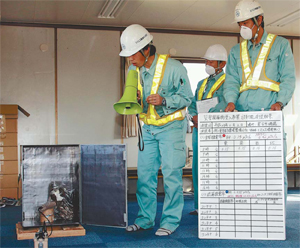TEPCO Denies Criticality
Generated Xenon At Fukushima Plant

Fukushima Power Plant
EMF Protection Devices
Magnetic Field Detector
November 03, 2011
Tokyo Electric Power Co. said Nov. 3 that naturally
occurring "spontaneous nuclear fission"--not a state of
criticality--created the xenon detected at the Fukushima No.
1 nuclear power plant.
The company said it reached that conclusion after evaluating
the state of nuclear fission based on the concentration of
xenon detected and temperatures and pressure levels at the
No. 2 reactor of the crippled plant.
Instead of being caused by self-sustaining nuclear fission,
the xenon was likely generated by spontaneous fission of
curium and other radioactive substances derived from the
reactor fuel, TEPCO said. Spontaneous fission takes place in
suspended nuclear reactors under normal conditions.
The company also said the xenon discovery will not affect
its schedule of having all of the damaged reactors reach a
stable "cold shutdown" state by the end of this year.
Radioactive xenon-133 and xenon-135 were detected Nov. 1
during an analysis of gas purified by a control system in
the containment vessel of the No. 2 reactor. Xenon-135 was
again detected on Nov. 2.
Xenon-133 and xenon-135 have relatively short half-lives of
about five days and about nine hours, respectively, which
raised concerns that nuclear fission had taken place in
recent days inside the reactor.
TEPCO officials initially said they could not rule out the
possibility that some parts of the fuel rods had reached
criticality, which can be caused when uranium fuel and water
are positioned in a well-balanced manner under certain
conditions.
Fuel rods in the No. 2 reactor are believed to have melted
and fallen to the bottom of the pressure vessel, partially
leaking to the containment vessel.
The Nuclear and Industrial Safety Agency (NISA) on Nov. 2
confirmed that radioactive xenon had been detected, but it
raised doubts that criticality had been reached. NISA said
xenon continued to be detected even after the injection of
boric acid water, which absorbs neutrons. Neutrons are a
requisite for criticality to occur.
NISA officials pointed to the possibility of spontaneous
fission, which can occur even in the absence of neutrons.
TEPCO adopted that view on Nov. 3.
Yet questions remain about the interior state of the
reactors. Scant data had been available, other than readings
of thermometers and pressure gauges, that could accurately
show the situation inside the reactor containment vessels.
TEPCO on Oct. 28 started operating equipment to block the
discharge of radioactive substances from the containment
vessel at the No. 2 reactor. This made it possible to
analyze the composition of gas within the vessel.
However, neutron detectors to check for nuclear fission,
water level gauges in the reactors, and other equipment
indispensable in monitoring the interior state of the
reactors have remained out of order since the March 11
tsunami swamped the nuclear plant.
Nuclear fission could also be taking place at the No. 1 and
No. 3 reactors, where fuel is believed to have melted. But
gas measurements are not immediately possible at those
reactors because high radiation levels are hampering the
installation of a device to control gas within the
containment vessel. That device was used to detect the xenon
at the No. 2 reactor.
TEPCO officials said large-scale criticality incidents were
unlikely at the plant because the water-injection system was
cooling down the reactors on a sustained basis.
Continued pumping of water into the No. 1, No. 2 and No. 3
reactors brought their temperatures below 100 degrees in
late September.
The government defines a cold shutdown as a state in which
the temperature at the bottom of the pressure vessel is 100
degrees or lower and the amount of radioactive substances
discharged from the reactor is suppressed at low levels.
"We do not believe that there is any impact on achieving the
goals in our road map toward bringing the crisis under
control," Junichi Matsumoto, acting general manager of
TEPCO's Nuclear Power and Plant Siting Division, said Nov.
2. "But how to monitor and control nuclear fission will be a
challenge for the future."
Another challenge that keeps popping up is swiftly
exchanging information about the Fukushima nuclear crisis.
Industry minister Yukio Edano on Nov. 2 admonished NISA
Director-General Hiroyuki Fukano for a delayed report on the
suspected nuclear fission at the plant, according to Chief
Cabinet Secretary Osamu Fujimura.
Fujimura said TEPCO informed NISA of the situation on the
night of Nov. 1, but the agency did not relay the
information to the prime minister's office until after 7
a.m. the following day.
NISA informed Edano still later, and Fujimura himself
learned about the situation only after he came to the prime
minister's office past 9 a.m.
"We should have been informed immediately of any indication
of possible nuclear fission," Fujimura said.
by Hidenori Tsuboya and Tatsuyuki Kobori
http://www.emfnews.org/store
|